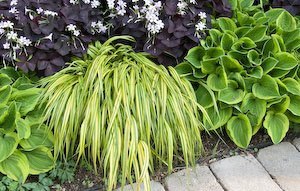The ornamental grasses for shade reveal a quiet beauty, while the sun-loving grasses tend to be big, bold and dramatic.
Shade grasses are easy-to-grow plants that fit nicely into the more serene and subtle nature of a shade garden, as long as the shade is not too deep. Most grasses need at least some sunshine. Partial or dappled shade is ideal.
Most of the plants listed below don’t grow as tall or look as bold as the sun-loving grasses, but they are handsome nonetheless.
Selected ornamental grasses for shade

Hakone grass makes an attractive combination with Hosta ‘Golden Tiara’ and purple-leafed oxalis
Photo: © Y.Cunnington
Try these terrific ornamental grasses for shade:
Japanese Forest Grass or Hakone Grass (Hakonechloa macra ‘Aureola’): This attractive grass is one of the best ornamental grasses for shade. It is hardy in USDA zones 5 to 9.
Although it is rhizomatous (spreading), it grows slowly and behaves itself, acting more like a clump-forming grass. It has striking gold variegated leaves with an attractive habit of falling over to one side.
Grows about 16 to 24 inches tall and 18 to 24 inches wide, and thrives in moist shade. More information about Hakone grass, the 2009 Perennial Plant of the Year.
Palm Sedge (Carex muskingumensis): Hardy to Zone 5, this sedge spreads to create a low maintenance groundcover for moist shady locations. The light green leaves resemble palm fronds at the top, which gives it its common name. This warm season sedge is native to low woods and moist meadows of central North America. Grows about 2 feet tall.
Palm Sedge (Carex muskingumensis): Hardy to Zone 5, this sedge spreads to create a low maintenance groundcover for moist shady locations. The light green leaves resemble palm fronds at the top, which gives it its common name. This warm season sedge is native to low woods and moist meadows of central North America. Grows about 2 feet tall.
Bowles Golden Sedge (Carex elata ‘Aurea’ or ‘Bowles Golden’): Hardy to Zone 5, it is another one of the best cool season clumping sedges. Has attractive lime-green leaves in early spring and makes a lovely companion to gold variegated hostas. Grows 2 feet tall and prefers moist shade.
Silver Variegated Japanese Sedge (Carex morrowii ‘Variegata’): This sedge is hardy to Zone 5. It has white leaf margins and grows 12 to 18 inches tall. It likes morning sun or part shade.
Variegated Sedge (Carex morrowii ‘Ice Dance’): Hardy to Zone 5, this semi-evergreen sedge has green foliage edged in pure white. One of the newer introductions, it spreads to create a low-maintenance groundcover in the shade garden.
Plantain-Leaved Sedge (Carex plantaginea): A clumping cool season sedge hardy to Zone 4. Grows 6 to 12 inches tall and has green leaf blades that are wider than most sedges. Among the grasses for shade, this is one of the best for tolerating dry conditions. It makes a nice companion to ferns and North American woodland natives.
Northern Sea Oats (Chasmanthium latifolium): Hardy to Zone 5, this clumping warm season grass grows about 3 feet tall. It has dark-green bamboo-like foliage and attractive dangling flowers in mid-summer. This grass can take quite a bit of sun. Warning: it can self-seed excessively, so remove flowers in late fall. The flowers are lovely in autumn cut-flower arrangements.
Snowy Woodrush (Luzula nivea): This woodrush is listed as hardy to Zone 6, but I’ve grown it successfully in Zone 5 for more than six years. A clump-former, it grows about 18 inches tall and is evergreen with light green leaves and clustered white flowers in May to June. In cooler climates, it can take sun, but you should give it light shade in hot dry conditions
Greater Woodrush (Luzula sylvatica): This evergreen, clump-forming woodrush has green foliage covered with silky hairs. It grows about 2 feet tall and flowers in late spring into early summer. It prefers moisture and light to medium shade, but is quite drought tolerant. In its native habitat in Europe and Asia, it grows on acid soil, but is tolerant of most soils. Makes a good companion to ferns, shade-loving wildflowers and shrubs.
Related Information
How to care for ornamental grasses for shade and sun
Switch grass (Panicum virgatum) cultivars to grow
Feather reed grass (Calamagrostis x acutiflora ‘Karl Foerster’)




